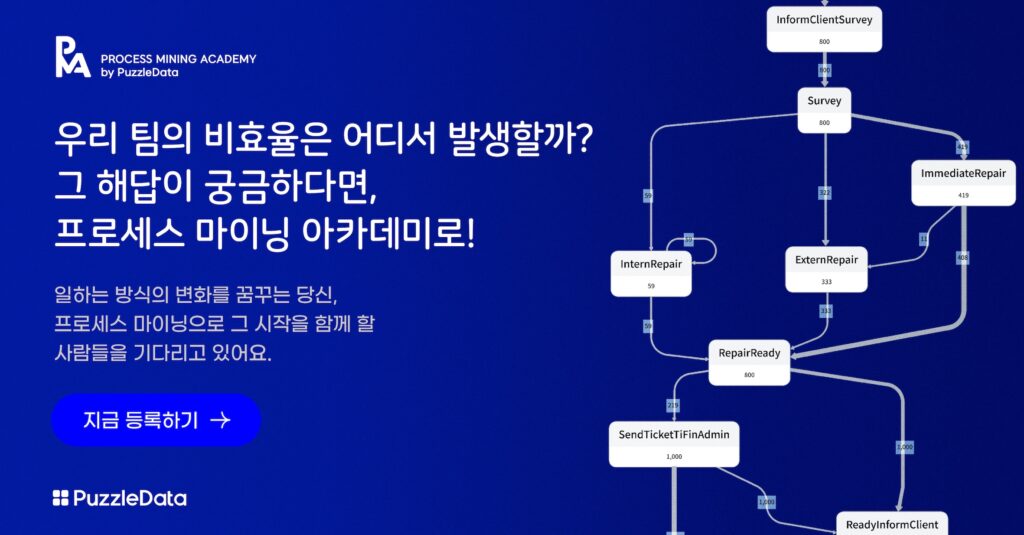Overcoming the Limitations of Data Analysis
Kwangseob Kim | Jul 30, 2019 | 7 min read
With the advancement of modern science, data is being acquired through various means such as social networks, emails, and phone calls, leading to an exponential increase in its volume. As a multitude of data accumulates, businesses are recognizing the necessity of data mining as a means for more effective analysis. This recognition has spurred active research across various fields on a global scale. Process mining is also gaining attention and research interest in several countries, including Germany, the Netherlands, and Italy.
In this article, we discuss the advantages of applying a process mining perspective to problems that were difficult to solve using traditional data mining alone, as well as the benefits of developing these two methodologies in a complementary manner.

Process mining vs data mining
The term ‘mining,’ which is commonly used in both process mining and data mining, carries the meaning of extracting valuable materials from the ground, akin to mining minerals. In other words, both methods aim to uncover hidden value by extracting information from data.
There are distinct differences between these two methodologies. First, data mining refers to the process of exploring and discovering relationships, patterns, and rules within large datasets to extract valuable knowledge. On the other hand, process mining can be seen as a methodology for ‘automated business process discovery.’ It focuses on analyzing event logs recorded in systems to discover and analyze patterns and processes that can be inferred from actual records.
In simpler terms, data mining analyzes what happened based on various data attributes, while process mining analyzes and visualizes data from a process perspective, focusing on discovering optimal processes or finding ways to improve or develop processes.
How process mining enhances data mining
Process mining can fill the gaps where data mining may fall short.
First, through behavior-based customer segmentation, businesses can define target customers and provide tailored services.
One of the data mining techniques, “cluster analysis,” involves partitioning data points into clusters based on distance to the centroid of a cluster. Data points within the same cluster are more similar to each other than to those in other clusters. However, in reality, customers often exhibit diverse behaviors, preferences, and needs. Some customers may have unique preferences and expectations that significantly differ from the cluster’s centroid. In these cases, target clusters may fail to capture these individual preferences. Therefore, it is important to understand the needs of each individual customer when analyzing vast amounts of data.
Process mining offers a holistic understanding of individual customer journeys and allows businesses to provide more accurate and personalized results compared to traditional clustering methods. With ProDiscovery’s Pattern Based Map, you can easily identify customer behavior patterns and segment customers exhibiting similar behavior. Using this approach, businesses can identify bottlenecks in segmented customer groups and design optimal routes, making it easier to cater to customer needs and achieve better marketing results.
Second, by keeping up with trends, businesses can adapt to evolving customer needs.
Data mining across various fields often involved analyzing customer feedback to improve certain aspects of products or services. However, this approach lacks a comprehensive strategy that aligns with current trends, as it relies on analyzing specific events. Process mining, on the other hand, analyzes the entire customer journey, examining various event log data such as customer behaviors and searches over time. This means that process mining can provide an in-depth understanding of how customer characteristics change over time and enable quick identification of trends. This allows businesses to develop more effective marketing strategies, particularly for planning new products, by focusing on what customers truly desire based on their evolving behaviors.
Third, predictive analysis and preventive action become possible.
When it comes to predicting business outcomes, data mining excels in its predictive power, efficiently identifying significant variables which are used to build predictive models. However, it often lacks a deep understanding of underlying business processes and causal relationships. This can limit its ability to explain why certain outcomes occur and hinder process optimization.
On the other hand, process mining specializes in providing a comprehensive view of business processes, facilitating a deeper understanding of their workings and allowing for root cause identification.
Businesses often benefit from a combination of both techniques, ultimately improving both predictive accuracy and operational efficiency.
Process mining aims to not only identify the reasons behind it but also to retain customers by understanding their intentions. While data mining techniques can analyze and predict customer attrition, understanding the detailed behavior patterns of churned customers can be difficult. Process mining, however, can utilize process maps and visually analyze detailed behavioral patterns of customers. It also allows for easier comparison and analysis between retained and churned customers. Integrating process mining and data mining in this manner can lead to improved and enhanced processes based on robust results.
In conclusion, if process mining and data mining complement each other to solve the issues each approach faces, they could enhance and grow research outcomes that may have been somewhat lacking. This article has examined the challenges encountered in data analysis and introduced process mining as a solution. While process mining may appear superior compared to data mining in this article, it is important to note that process mining alone may not address all challenges. There are various methodologies beyond data and process mining, and none are flawless. As data analysts, we must continuously strive to tackle these challenges. While this article has focused on process mining, it’s not the only solution; it’s intended to stimulate discussions, opinions, and debates on various approaches to address and resolve complex problems.
Reference
https://www.coursera.org/learn/process-mining Process Mining: Data Science in Action
#퍼즐데이터 #프로디스커버리 #프로세스마이닝 #PuzzleData #ProDiscovery #processmining #프로세스인텔리전스 #ProcessIntelligence #datamining #디지털트랜스포메이션 #디지털혁신 #프로세스혁신 #digitaltransformation #Webinar #업무혁신 #TaskMining #태스크마이닝 #프로세스분석 #데이터분석 #프로세스개선

